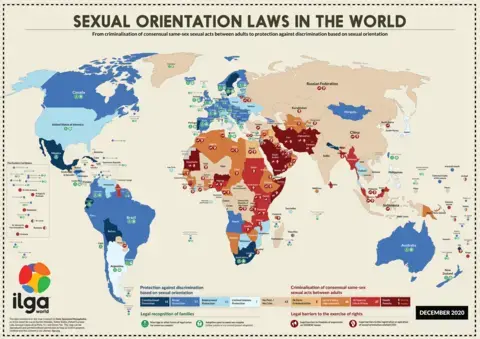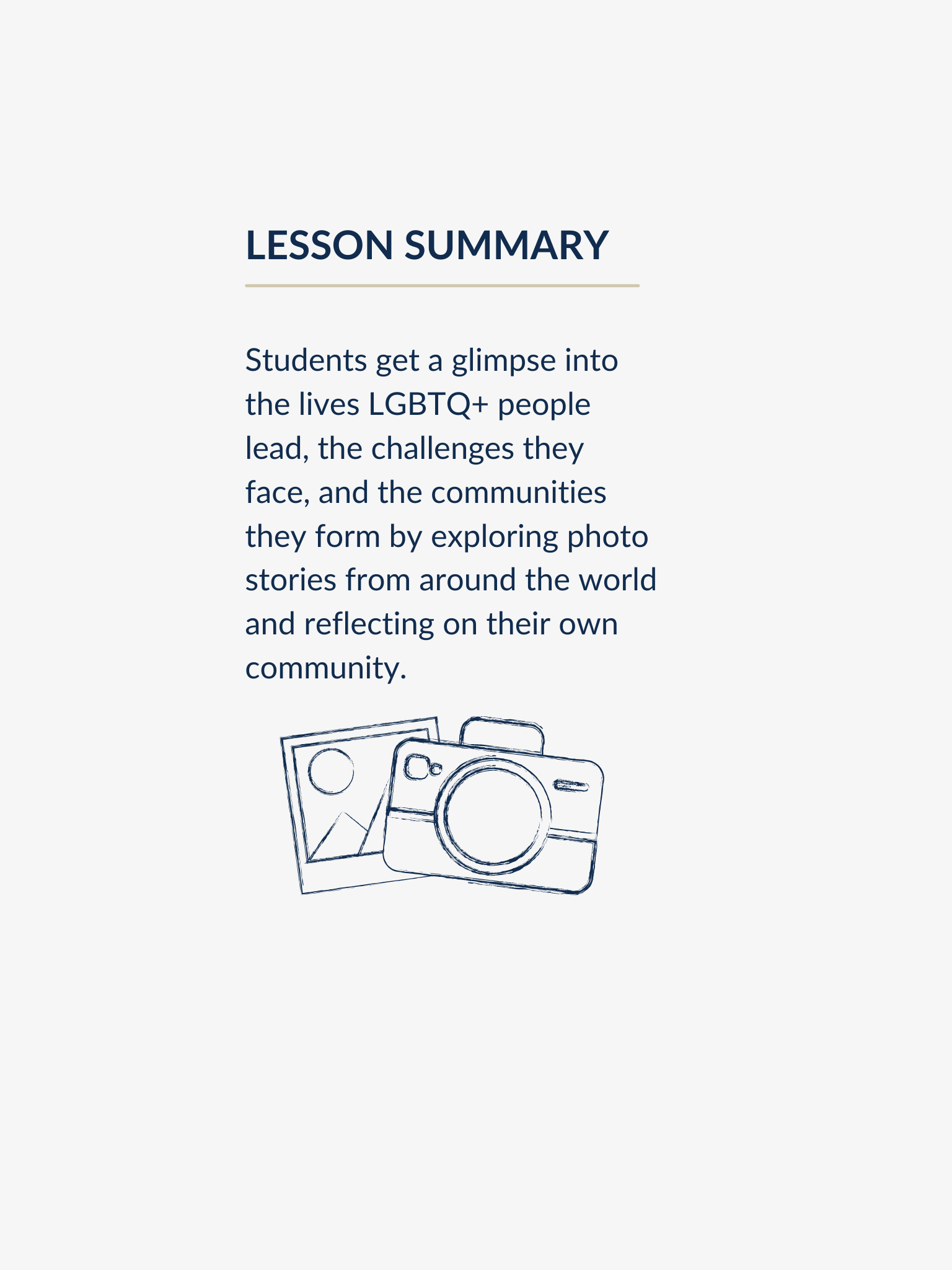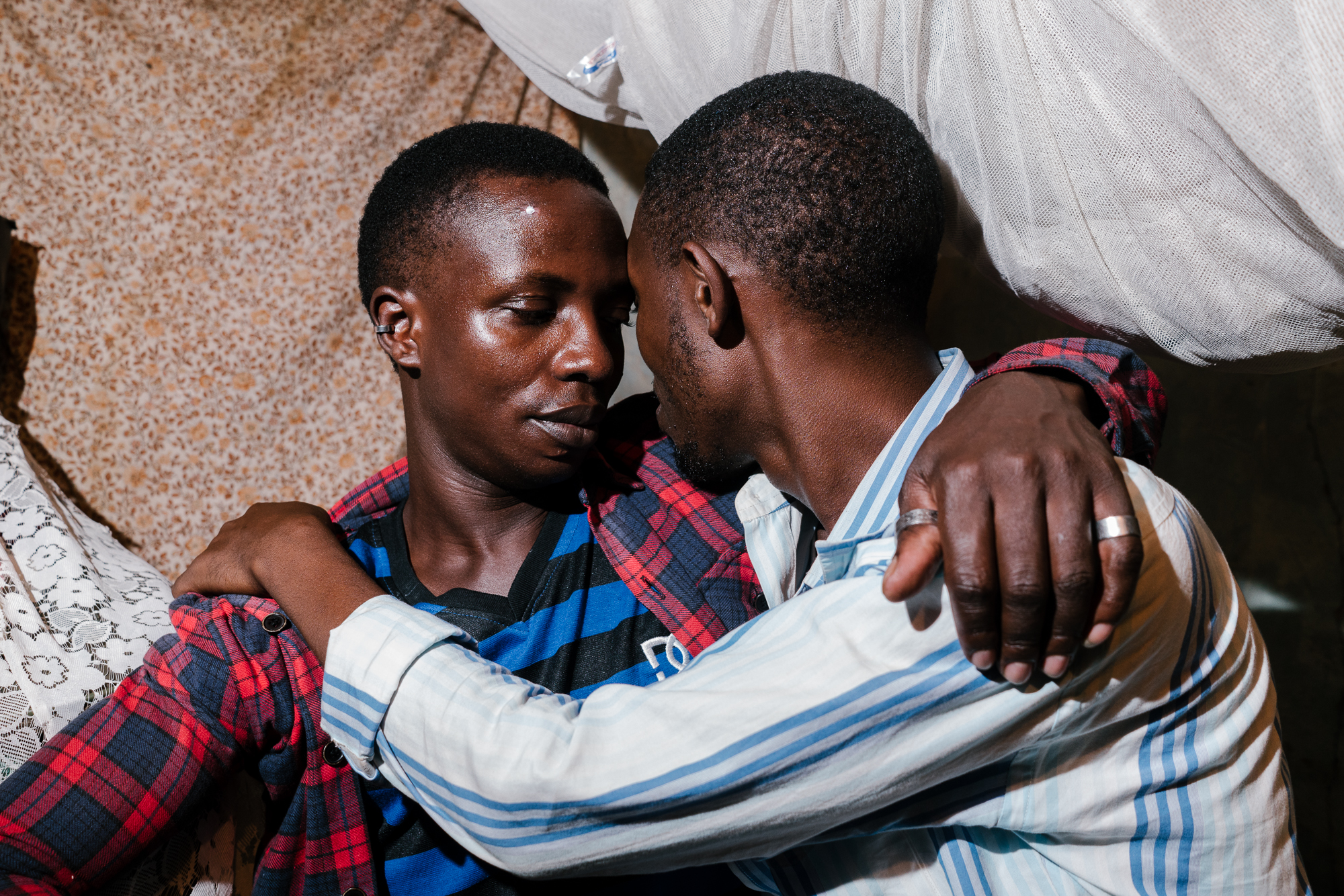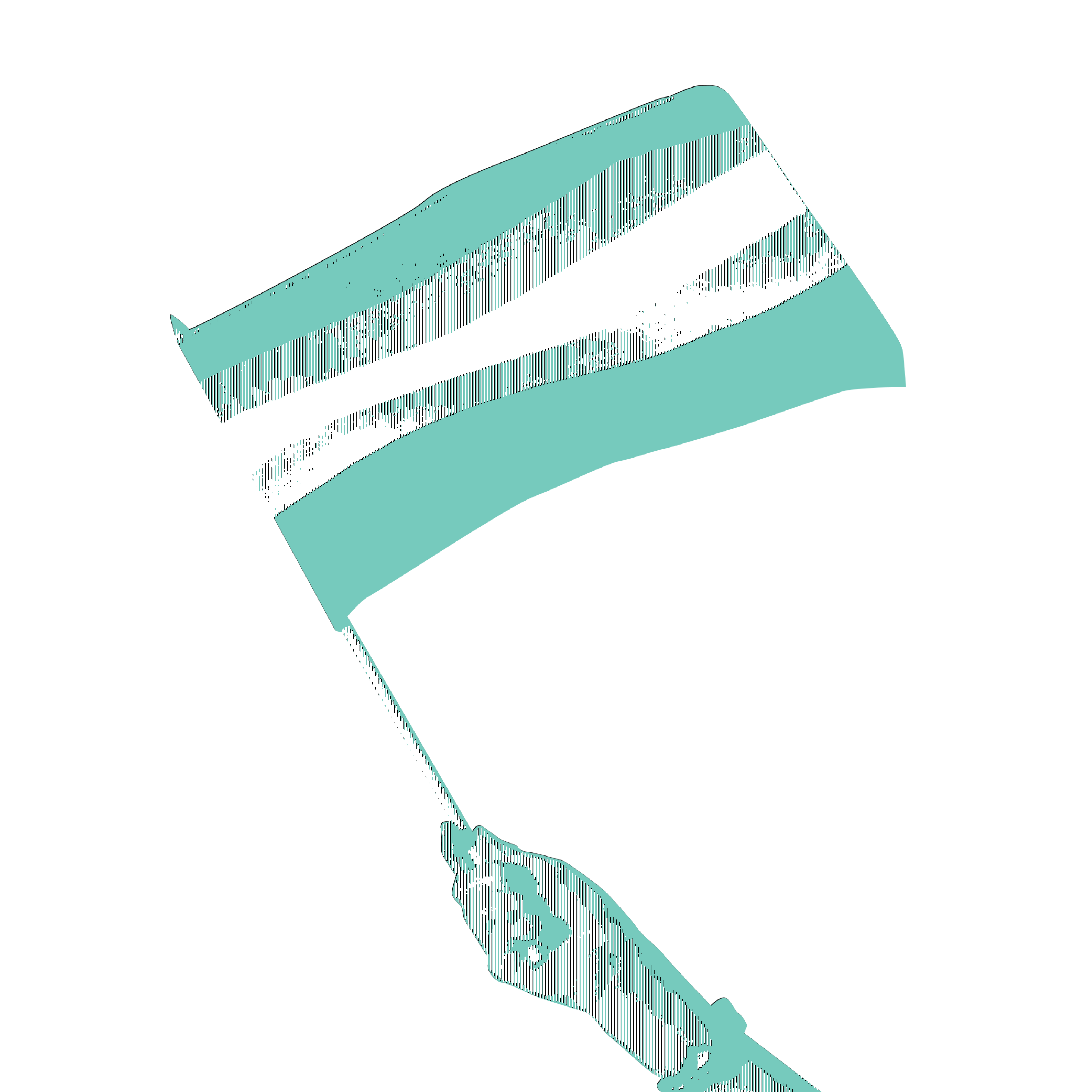Objectives:
Students will be able to…
- Understand that LGBTQ+ people live and form communities around the world, globally and locally
- Compare how LGBTQ+ people live in different countries and the challenges they experience
- Analyze photography as a tool for documenting personal and social identity
- Use photography to express their own identity, or the identity of another person as they understand themselves
Warm-up:
1. As a class, discuss: What identities are, and aren’t, included in the acronym LGBTQ+?
2. Take a moment to look up the acronym LGBTQ+ independently. Click here for one resource with a list of related terms and their definitions. Do the definitions you explored add anything new or different from your original understanding of the acronym? Share and discuss as a class.
3. As a class, discuss:
- What are the names of some openly LGBTQ+ public figures who you admire, such as artists, activists, politicians, or others? Where are each of those people from?
- What experiences do you think LGBTQ+ people in countries around the world might share? What experiences do you think might differ?
5. Individually, in small groups, or as a class, explore one or more maps to learn about the experiences of LGBTQ+ people in different places across the country or around the world. For example, you might explore:
- Sexual Orientation Laws in the World, a map by the International Lesbian, Gay, Bisexual, Trans and Intersex Association (ILGA) - see map below
- Progress of LGBTQ+ Rights Around the World, a map by Equaldex
- Snapshot: LGBTQ+ Equality by State, a detailed U.S. map by the Movement Advancement Project
Check the dates when maps were last updated, and analyze their legends carefully to understand how equality is being measured. After analyzing the map(s), discuss as a class:
- What are some of your key takeaways from the map? What observations and inferences can you make?
- What surprises you, and why?
- What questions do you have that aren't answered by the map(s) you explored?

Introducing the Lesson:
LGBTQ+ people live all over the world, and communities vary in the degree of social acceptance and legal status they extend.
The maps explored in the warm-up show the legal status of LGBTQ+ people in different states/countries, which ranges from protections against discrimination and harm to criminalization of trans and/or queer expression and/or identity.
Such laws and policies are constantly evolving, and vary in their application. Moreover, policy maps do not capture the whole of what it's like to live as an LGBTQ+ person in different places. Many factors in addition to the law influence inclusion and quality of life, such as presence and strength of openly LGBTQ+ community, economic opportunity, and access to health care. LGBTQ+ rights are also inseparable from the social and legal landscape surrounding the many other identities with which queer and trans identities intersect, such as race, ethnicity, disability, religion, and migration status.
Photography is one way to see beyond the abstract. In this lesson, students will explore three photo stories in order to get a glimpse into the lives of LGBTQ+ people around the world. As students explore these photo stories, they will gain a better understanding of different challenges that people belonging to the LGBTQ+ community experience around the world, and the strong communities LGBTQ+ people form.
Vocabulary for This Lesson:
- Define terms related to LGBTQ+ identity, such as queer, trans, gender identity, and gender expression, using a source such as this glossary.
- Refugee: People who have fled war, violence, conflict or persecution and have crossed an international border to find safety in another country. Legally defined as “someone who is unable or unwilling to return to their country of origin owing to a well-founded fear of being persecuted for reasons of race, religion, nationality, membership of a particular social group, or political opinion.” (Source: UNHCR)
- Community: The people living in one particular area or people who are considered as a unit because of their common interests, social group, or nationality. (Source: Cambridge Dictionary)
- Consider asking students to expand on and personalize this definition. What does community mean to them? What communities do they belong to?
Introducing the Reporting:
Working in small groups or independently, students can choose one of the following stories to explore, or, time permitting, explore them all. While they explore, students should capture key takeaways from the story (or stories) by taking notes in a graphic organizer like the one below.
- “Tam's Comeback: Diary of First Visit Home After Transitioning”: This photo story focuses on a 23-year-old dancer who came out as non-binary during the pandemic while living in Buenos Aires, and returns to the more traditional society of Bolivia to find their place at home.
- “'Gayropa': Challenges and Hopes of Europe's LGBT+ Refugees – in Pictures”: This photo project documents LGBTQ+ refugees as they seek asylum across Europe, the discrimination they face, and the ways they find community.
- “East Africa’s Queer Community Searches for a Home of Its Own”: This photo story delves into anti-LGBTQ+ legislation and violence in Uganda, how it has led to forced migration, and how some choose to return to Uganda despite the risk. Content notes: General discussion of violence against LGBTQ+ people, self-harm, and sexual activity.
| “Tam’s Comeback” (Bolivia/Argentina) | “Gayropa” (Europe) | “East Africa’s Queer Community” (Uganda) | |
| What are some challenges for LGBTQ+ people in this story? | |||
| What are some ways in which LGBTQ+ people find community in this story? | |||
| How do the photos help tell the story? |
Discussion Questions:
As a class or in rotating small groups, guide students through a discussion of LGBTQ+ life and community around the world, and the representation of these communities in different forms of media. Students should use details from the story (or stories) they explored and their own reflections to respond to the following questions. Students may also continue filling in their graphic organizer for stories they did not get the chance to explore by taking notes on what their peers share.
- What’s something you learned about LGBTQ+ communities in other parts of the world that you didn’t know before?
- Have these stories challenged, expanded, or reinforced any of your own ideas about LGBTQ+ experiences? If so, how?
- What do you think are some reasons that LGBTQ+ people build communities where they live?
- What are some of the reasons people belonging to the LGBTQ+ community are compelled to migrate to different countries?
- Share a photo that stood out to you from the story you explored. Why does this image stand out to you? What does it communicate?
- How do you think photos communicate differently than words?
- When you want to express your own identity and ideas, what forms of expression do you like to use, and why
In-class Activity Ideas:
Activity 1: Ask students to form small groups with others who explored the same story. Each group should select the photo that stood out to them most, and prepare to share with the class:
- What did you learn from the photo? What information can you gather by looking closely?
- Why did this photo stand out to you? Think about the visuals/aesthetics, the feelings you get when you see it, how the subject may seem familiar or unfamiliar to you.
- What do you think made this photo powerful within the context of the story?
After making selections, each group should present their photo and their responses to the questions. The whole class can then form a word cloud for each picture in which every student contributes one word the photo brings to mind. (This can be done on a whiteboard, poster, or online app like Mentimeter.) To close, ask students to analyze the word cloud and discuss how the words relate to the stories they explored today and the themes they discussed.
Activity 2: Direct students to form small groups and research online how the LGBTQ+ community in their local town or nearest city looks, gathers, and organizes. Students can organize their research and record their findings by responding to the following questions on a note-catcher:
- What can you find out about the demographics of the LGBTQ+ community where you live from sources like population surveys?
- Look up local laws related to gender identity and sexual orientation.
- What legal protections exist for LGBTQ+ people, if any?
- What laws and policies criminalize LGBTQ+ people and expression, if any?
- Where do LGBTQ+ people gather in your community? (bookstores, community centers, sports leagues, etc.)
- How are LGBTQ+ organizing and advocating in your community?
- What queer organizations and people are engaged in organizing?
- What are they fighting for?
After researching, students share out with the whole class:
- What is one finding that was interesting or surprising to you?
- What do you think it means for a community to be “LGBTQ+-friendly”? How LGBTQ+-friendly would you say your local community is, and why?
- What similarities and differences can you see between your local community and the ones you read about today?
Extension Activities:
Option 1: Photography Project
Take a photo, or a short series of photos, that represents an important identity for you, a family member, or a friend. Use the Pulitzer Center photo stories above as inspiration.
- If you choose to take a photo of someone else, talk to them first about what identity they want to express in your image (gender, sexuality, race, ethnicity, nationality, religion, or something else entirely). Once you’ve discussed the focus of the photo with your subject, encourage them to dress, move, and pose however they feel most authentic and comfortable for the photo. Think about the background of the photo too, and how it changes the meaning of the image. Experiment until you find one that both you and your subject are happy with. After deciding on your final image, consider asking your subject for a quote on what the photo represents to them.
- If you choose to take a photo of yourself, use the same process, engaging in self-reflection instead of conversation. Choose the identity you want to express, a background, your style of dress, and your pose. Try using a self timer if you want to put down the camera. Afterwards, reflect on your final image and how it conveys your identity.
Some additional factors to consider:
- What is the power dynamic between photographer and photo subject? How does that influence the result?
- Would you consider the identity that you are trying to express dominant or marginalized? How does that change the way your photo will be viewed?
The quality of the photo is not important. What matters is the way you express identity. Next, write a short caption (2-3 sentences) to explain the photo to an outside viewer.
Photos can be shared with the class on a voluntary basis.
Option 2. Write a Letter Advocating for Change
What issues are affecting the LGBTQ+ community where you live? Do some brainstorming and research, and then write a letter to a local representative calling for action on an issue of your choice. In your letter, express your concern about the issue you are calling attention to. You can mail or email a letter to most elected representatives. Consider writing to a local, state, or national representative. In addition to sending letters to their chosen representatives, students writing can also enter their letters into the Pulitzer Center's annual writing contest, Local Letters for Global Change, for the chance to win prizes and publication. (Contest is open September - November annually.)
Option 3. Artivism
Art can be used as an instrument to inspire social and political change. Artivism is a term that describes the intersection of activism and art. With this in mind, create a piece of art that calls attention to an issue affecting the LGBTQ+ community. You can draw, paint, write a poem, choreograph a dance, or use photography to inspire change. Be creative and have fun. Consider sharing your work on social media or display it at school to inspire local action.










